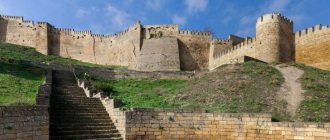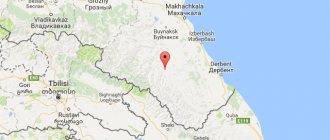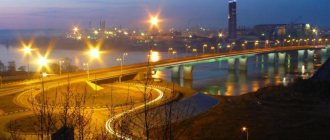The Republic of Dagestan
A subject of the Russian Federation, a republic within it.
It is part of the North Caucasus Federal District and is part of the North Caucasus Economic Region. Established on January 20, 1921 as an autonomous republic within the RSFSR. The capital of the republic is the city of Makhachkala .
Content:
- Administrative division
- Geography
- Hydrography
- Climate
- Demography
- National composition
It borders with the Republic of Azerbaijan in the south, with Georgia in the southwest, as well as with the Chechen Republic in the west, with the Stavropol Territory in the northwest and with the Republic of Kalmykia in the north.
According to the Constitution of the Republic of Dagestan, the state languages are Russian and the languages of all peoples inhabiting the republic. Among them, Avar, Agul, Azerbaijani, Dargin, Kumyk, Lak, Lezgin, Nogai, Rutul, Tabasaran, Tat, Tsakhur languages have written languages and official status.
Religion
About 90% of the population of Dagestan profess Islam, Sunnis make up 87%, Shiites-Imami - 2.4%. In addition, more than 40 Christian communities and associations are registered in the republic, among which are the parishes of the Russian Orthodox Church, the Russian Orthodox Old Believer Church, the Roman Catholic Church, the Armenian Apostolic Church, communities of Baptists, Evangelical Christians, Pentecostals and others.
All parishes of the Russian Orthodox Church are located in the north of the plain and in large cities. Among the Orthodox Christians, the majority are descendants of immigrants from southern and central Russia, as well as people from the Greben and Terek Cossacks.
Initially, the Orthodox parishes of Dagestan were subordinate to the Caucasian and Black Sea Diocese, created on July 17, 1842, with its center in the city of Stavropol, and since 1860 - to the Georgian Diocese of the Georgian Exarchate of the Russian Orthodox Church, with its center in Tiflis. Orthodox Christians on the territory of the Terek Cossack Army (Terek region) belonged to the Vladikavkaz diocese until 1917. Subsequently, the Orthodox parishes of Dagestan were subordinate to the bishop of the Stavropol region with a see in Stavropol.
On December 28, 1998, the territory of the republic entered the jurisdiction of the Baku and Caspian diocese of the Moscow Patriarchate.
On March 22, 2011, the parishes of Dagestan were included in the revived Vladikavkaz and Makhachkala diocese.
On December 26, 2012, the independent Makhachkala diocese was separated from the Vladikavkaz diocese, which included the parishes of the Republic of Dagestan.
The Orthodox parishes of the republic are divided into Makhachkala and Kizlyar deaneries. All parishes have Sunday schools.
Administrative division
Dagestan is divided into four territorial districts:
- Central territorial district
- Northern Territorial District
- Mountain territorial district
- Southern Territorial District
Dagestan includes 42 municipal districts and 10 urban districts
| N | Municipal district | District | Administrative center |
| 1 | Buynaksky district | Central | Buinaksk |
| 2 | Karabudakhkent district | Central | With. Karabudakhkent |
| 3 | Kayakent district | Central | With. Novokayakent |
| 4 | Kizilyurt district | Central | Kizilyurt |
| 5 | Kumtorkalinsky district | Central | With. Korkmaskala |
| 6 | Sergokalinsky district | Central | With. Sergokala |
| 7 | Babayurt district | Northern | With. Babayurt |
| 8 | Kazbekovsky district | Northern | With. Dylym |
| 9 | Kizlyarsky district | Northern | Kizlyar |
| 10 | Novolaksky district | Northern | With. Novolakskoe |
| 11 | Nogai district | Northern | With. Terekli-Mekteb |
| 12 | Tarumovsky district | Northern | With. Tarumovka |
| 13 | Khasavyurt district | Northern | Khasavyurt |
| 14 | Akushinsky district | Mountain | With. Akusha |
| 15 | Akhvakh district | Mountain | With. Karata |
| 16 | Bezhtinsky section | Mountain | With. Bežta |
| 17 | Botlikhsky district | Mountain | With. Botlikh |
| 18 | Gergebil district | Mountain | With. Gergebil |
| 19 | Gumbetovsky district | Mountain | With. Mehelta |
| 20 | Gunibsky district | Mountain | With. Gunib |
| 21 | Kulinsky district | Mountain | With. Wachi |
| 22 | Laksky district | Mountain | With. Kumukh |
| 23 | Levashinsky district | Mountain | With. Lefties |
| 24 | Tlyaratinsky district | Mountain | With. Tlyarata |
| 25 | Untsukulsky district | Mountain | With. Untsukul |
| 26 | Khunzakhsky district | Mountain | With. Khunzakh |
| 27 | Tsumadinsky district | Mountain | With. Agvali |
| 28 | Tsuntinsky district | Mountain | With. Tsunta |
| 29 | Charodinsky district | Mountain | With. Tsurib |
| 30 | Shamilsky district | Mountain | With. Hebda |
| 31 | Agulsky district | Southern | With. Tpig |
| 32 | Akhtynsky district | Southern | With. Oh you |
| 33 | Dakhadaevsky district | Southern | With. Urkarah |
| 34 | Derbent district | Southern | Derbent |
| 35 | Dokuzparinsky district | Southern | With. Shrink it |
| 36 | Kaytag district | Southern | With. Majalis |
| 37 | Kurakhsky district | Southern | With. Kurakh |
| 38 | Magaramkent district | Southern | With. Magaramkent |
| 39 | Rutulsky district | Southern | With. Rutul |
| 40 | Suleiman-Stalsky district | Southern | With. Kasumkent |
| 41 | Tabasaran district | Southern | With. Huchni |
| 42 | Khiva district | Southern | With. Khiv |
Urban districts of the Republic of Dagestan
| N | Urban district | District |
| 1 | Makhachkala city | Central |
| 2 | Buinaksk city | Central |
| 3 | Izberbash city | Central |
| 4 | Kaspiysk city | Central |
| 5 | Kizilyurt city | Central |
| 6 | Kizlyar city | Northern |
| 7 | Khasavyurt city | Northern |
| 8 | City of Yuzhno-Sukhokumsk | Northern |
| 9 | City of Dagestan Lights | Southern |
| 10 | City of Derbent | Southern |
List of cities in Dagestan - brief information
Each of the major Dagestan cities has its own interesting history. Not all of them have at least a hundred years of city status, but the population of any of them contributed to the history and prosperity of the republic. It's worth getting to know them better.
- Makhachkala is the capital, political and economic center.
The largest city in the Republic of Dagestan, it is home to about 588,000 people. Once upon a time there was Tarki-aul on this place, which served as a trading hub where caravans heading to Derbent stopped. The future city was founded in 1844 as the Petrovskoye fortress, and a little later this village was renamed Petrovsk.
Rapid development began at the end of the 19th century with the construction of the railway from Rostov to Baku. In 1914, there were already several large industrial enterprises here, including an oil refinery. The city's population grew and its infrastructure became more and more developed. But real prosperity began only under Soviet rule.
In 1921, Petrovsk received a new name - Makhachkala, in honor of Makhach Dakhadayev, a local revolutionary. Since the 30s, rapid development of both industry and the social sphere began here. A real water supply system appeared, streets and new neighborhoods were built up, hospitals and schools were built, and even defense enterprises appeared.
With the beginning of perestroika, the economy of Dagestan began to decline, many enterprises were closed, and jobs were reduced. At the turn of the 20th and 21st centuries, radicals of extremist movements of Islam began to penetrate here; the capital of the republic had a very difficult time during these years. However, with the arrival of the new city government, improvement began again. Moreover, at the beginning of the 21st century, Makhachkala was recognized as one of the most comfortable Russian cities. The Dagestan capital is considered one of the important scientific and economic centers of the North Caucasus.
- Derbent is the ancient and southernmost city of Russia.
It is one of the most ancient cities in the world. It has been known since the 3rd century BC, as many ancient sources mention it. Initially, Derbent was one of the fortresses that belonged to Persia and was considered a major military center. In the 18th century, Peter the Great came here.
Many studies have been written about the history of Derbent; it is so rich and diverse that it can be told for a long time. The city was under the rule of the Seljuks, Tamerlane himself, and the Safavid dynasty. And in 1813 it finally became part of the Russian Empire.
Derbent is one of the cities in the southern territorial district of Dagestan. Today its population reaches more than 120 thousand people. People of various nationalities live here. There are food industry enterprises and as many as 4 theaters. On September 19, 2015, the city officially celebrated its 2000th anniversary. Such a respectable age does not make it old - the city still looks young and is developing.
- Khasavyurt is the patrimony of the Kumyk prince Khasav.
Until 1847, this settlement was called Yaryksuw (after the name of the local river Yaryksu). The aul was on the path of the khan's raids and was destroyed several times. Having arrived in the Caucasus, the Russians built a fortress here, and the population was actively engaged in agriculture. The agricultural sector is still developed in Khasavyurt today, but many food industry enterprises are closed. The population is 138 thousand people. The city gained new fame in 1996, when the famous Khasavyurt agreements were signed here.
- Dagestan Lights.
This unusual name was given to the city by gas flares - gas emissions from underground as a result of an earthquake. This happened in 1904, and a few years later small private enterprises began to appear in these places. Gradually a settlement arose; the official date is considered to be 1914. The village was granted city status only in 1991.
Thus, Dagestan Lights is the youngest city in the Republic of Dagestan; it is still a satellite of Derbent. It is interesting that during the Great Patriotic War the local glass factory produced Molotov cocktails as a product. This same enterprise today is the largest and most famous in the city. The population of Dagestan Ogni is about 30 thousand people.
- Buynaksk
Another one of the oldest Dagestan cities, founded as an aul at the end of the 14th century. In 1832, the Russian fortress Temir-Khan-Shura arose here. During the Civil War, this settlement was the capital of the Mountain Republic.
The city received its modern name in honor of the revolutionary Ullubiy Buynaksky. About 64,000 residents live here; like other cities in Dagestan, it is international.
- Kizlyar is a famous center of gunsmiths.
It is believed that Kizlyar was founded in 1735, but long before this date there was an ancient settlement here, one of the Arab fortresses. The starting point for the city was given by General-in-Chief V. Ya. Levashov, who built a Russian fortification here. At the turn of the 18th-19th centuries, Kizlyar was a very famous shopping center.
Currently, the agricultural industry is developed here, with several wine and cognac enterprises operating. Initially, the population was predominantly Russian, but today the majority here are representatives of Dagestan nationalities. Number of people: 48,000 people.
World-famous Kizlyar knives brought glory to the city. There are large arms factories in the city. Among them are LLC PP Kizlyar, Poisk, Berkut, etc. A huge selection of products from Kizlyar craftsmen is presented in the catalog of the KavkazSuvenir store.
- Izberbash.
This is a young city, founded in 1932, in which the oil industry is mainly developed. It received its status in 1949. It was the oil workers who rebuilt Izberbash and can be proud that in 2005 it was recognized as the most comfortable Russian city.
- Kizilyurt.
Another of the cities of the republic that arose in the 19th century. There was a fortification of local residents here, on the basis of which a settlement subsequently arose. Currently, about 36 thousand people live here, and the city thrives due to many enterprises in the construction sector, as well as tourism.
- Yuzhno-Sukhumsk.
This small town has a population of just over 10 thousand, and it received city status in 1988 (before that it was considered a village). The main direction of the economy is oil production. The favorable location of the city between Kizlyar and Stavropol allows the trade sector to develop.
- Kaspiysk is the base of the Anzhi football club.
It is located next to Makhachkala and is its satellite city; the only airport in the Republic of Dagestan is located here. Until 1947, it was the village of Dvigatelstroy, which already speaks of the direction of industry that developed here. In 2015, by order of the Government of the Russian Federation, it was included in the list of single-industry towns with the most difficult socio-economic situation. The population of Kaspiysk is more than 110,000 people.
Geography
Dagestan is located in the northeastern part of the Caucasus, along the coast of the Caspian Sea. In the northern part of the republic there is a lowland, in the southern there are foothills and mountains of the Greater Caucasus. The length of the territory from north to south is about 400 km, from west to east - about 200 km. Dagestan borders on the Stavropol Territory and Kalmykia in the north, the Chechen Republic and Georgia in the west, and Azerbaijan in the south. On land and the Caspian Sea there are borders with five countries - Azerbaijan, Georgia, Kazakhstan, Turkmenistan and Iran. On the border with Azerbaijan is the southernmost point of Russia (41°10′ N).
Hydrography
From the east, the territory of Dagestan is washed by the waters of the Caspian Sea. The south and middle part of the republic are occupied by the mountains and foothills of the Greater Caucasus, in the north the Caspian Lowland begins.
Rivers
The Terek and Sulak rivers flow through the central part of the republic. There are 6,255 rivers flowing in Dagestan (including 100 main rivers, with a length of more than 25 km and a drainage area of more than 100 km, 185 small and more than 5,900 smallest ones), the largest of which are Terek, Sulak, Samur, Rubas with tributaries. All rivers belong to the Caspian Sea basin, but only 20 of them flow into the sea.
Due to the dry climate, the north of Dagestan is poor in rivers. The existing rivers are used for irrigation in the summer and do not reach the sea.
The most abundant rivers are mountain rivers, which, thanks to their fast flow, do not freeze even in winter; they are characterized by comparative abundance of water and significant slopes.
Samur is the second largest river in Dagestan. The area of its basin is 7.3 thousand km². The source is located in the Rutul region of Dagestan. When it flows into the Caspian Sea, the Samur splits into branches and forms a delta. It is planned to build three hydroelectric power stations on the river and its main tributaries. The waters of Samur are also used for irrigation purposes: irrigation canals have been drawn from the river to irrigate Southern Dagestan (Samur-Derbent Canal) and neighboring Azerbaijan (Samur-Apsheron Canal).
Sulak is formed at the confluence of the Kazikumukhskoe Koisu, Avar Koisu and Andiyskoe Koisu rivers, which originate in the Greater Caucasus Mountains. The area of its basin is 15.2 thousand km². Sulak accounts for half of all hydropower resources in Dagestan; the Chirkeyskaya HPP, Miatlinskaya HPP, Gelbakhskaya HPP, Chiryurt HPP-1 and Chiryurt HPP-2 are located here.
Lakes
Lake Kezenoyam (Botlikhsky district, most of the lake belongs to the Vedeno district of Chechnya) - the largest and deepest mountain lake in the North Caucasus
Nizhnetersky lakes
Lake Ak-Gol - Makhachkala
Interesting facts about Dagestan cities
- The only ice-free port in Russia is located in Makhachkala.
- At one time, the republic was assigned a certain postal code. Today, the indexes of the cities of Dagestan are 368000 (the last three digits change), and the code of the region itself is 05.
- Each of the cities of the republic is distinguished by its originality. If you walk along the streets of Derbent, you can catch the charm of antiquity. And the streets of Kaspiysk and Izberbash delight the eye with clearly drawn lines and architecture typical of the Soviet period.
- Coastal cities include Derbent, DagOgni, Makhachkala, Kaspiysk and Izberbash. The rest do not have access to the Caspian Sea.
- Despite the fact that the territory of Dagestan is predominantly covered with mountain ranges, not a single city is even included in the top ten highest altitude large settlements in the Caucasus.
Climate
The climate in the north and central part of Dagestan is temperate continental and arid.
Dagestan is divided into three soil and climatic zones:
- mountainous - above 850 (1000) m (area 2.12 million hectares or 39.9% of the territory)
- foothill - from 150 (200) to 850 (1000) m (area 0.84 million hectares or 16% of the territory)
- flat - from −28 to 150 (200) m (2.35 million hectares or 43.3% of the territory).
Average temperatures in January range from +4°C in the valleys to −11°C in the highlands, in July from +30°C in the valleys to +8°C in the highlands. Precipitation per year is 200–300 and 600–800 mm, respectively.
The growing season is 200-240 days.
Demography
The population of the republic, according to Rosstat, is 3,063,885 people. (2018). Population density - 60.95 people/km2 (2018). Urban population - 45.16% (2018).
According to the government of the republic, more than 700 thousand Dagestanis permanently live outside its borders.
The birth rate is 19.5 per thousand population (3rd place in the Russian Federation, after Ingushetia and the Chechen Republic), the birth rate for 2010 is 18.8 per 1 thousand people. The average number of children per woman is 2.13.
The mortality rate at the end of 2022 was 5.1 ppm. Taking into account the total population, it turns out that 15,626 people die per year in the Republic of Dagestan region.
According to preliminary official data from the 2010 population census, the population of Dagestan increased by 15.6% compared to 2002 and reached 2977.4 thousand people. The share of the urban population increased from 42.8 to 45.3%. The share of men and women remained stable (the share of men decreased by 0.1% and amounted to 48.1%).
Dagestan showed the highest population growth rates among Russian regions. Thanks to this, the Republic overtook many large regions in 2002-2010 (Krasnoyarsk Territory, Volgograd Region, Perm Territory, etc.). As of 2022, Dagestan ranks 13th in Russia in terms of population of constituent entities of the Russian Federation.






